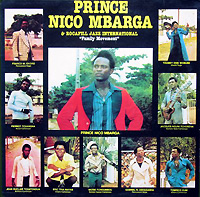Ghana and Nigeria: the golden years
Highlife, afrobeat and juju music
Paris
25/03/2010 -
Soundtrack to independence

In 1953, E.T. Mensah recorded an album with The Tempos entitled All For You, which was instrumental in popularising highlife outside Ghana. The following year, the first vinyl record plant started business in West Africa, in Kumasi in southern Ghana. All for you was rapidly distributed across the region, in 78 and 45 rpm vinyl format.
Two years later, E.T Mensah played with Louis Armstrong (who was touring West Africa) at his club in Accra, the Paramount. Ghana at this time had become a veritable cultural and political hub for West Africa: in 1957 Kwame Nkrumah became president of the first newly independent state in Africa.
Highlife became the soundtrack to this period of cultural and political effervescence. E.T Mensah’s musical style was quickly copied and gave birth to a whole generation of artists such as The Ramblers, Gyedu Blay Ambolley, Hedzoleh Soundz and Ebo Taylor. Many groups across West Africa adopted this Ghanaian fusion of jazz and calypso.
From highlife afrobeat

The track Highlife Time by Nigerian Fela Ransome Kuti is a good reflection of Ghana’s influence on its English-speaking neighbour. In his early days, in the mid-60s, Fela and the Koola Loobitos went on a ten-month American tour. It was a tough experience, but Fela eventually returned to Lagos in 1970 a changed man. He had met the Black Panthers and discovered the importance of his own culture.
The Koola Loobitos changed their name to Nigeria 70. On stage, Fela would raise his fist just like the American Black Panthers, which no one in Nigeria had yet heard of. His new militant identity didn’t immediately go down well with the public, who were more in tune with the afrofunk of the likes of Géraldo Pino from Ghana. But with J’eun Koku (the glutton), Fela finally found his inspiration in the social and political issues and the everyday concerns of millions of Nigerians. The Afro Spot, the club he managed, was renamed Africa Shine, and every evening Fela would sing his message of liberation, PanAfricanism and black pride.
Artistic crossroads

Ghana and Nigeria became veritable artistic crossroads. For example, on 6 March 1971, the Soul To Soul concert in Accra was able bring together some of the best artists from Ghana and America: Roberta Flack, Ike & Tina Turner and Wilson Pickett participated in this historic musical meeting of two continents. At the same time in London, the fusion group Osibisa, founded by Ghanaian and Caribbean artists in exile, sold 25,000 copies of their debut album. Osibisa were the first African group to enjoy such a success away from home, and as such were precursors to the whole “world music” movement that would emerge ten years later.
High point, followed by decline

But once this cultural explosion reached its peak, decline set in rapidly. In 1977, FESTAC (the World Black and African Festival of Arts and Culture) brought together artists from 69 countries in the Nigerian capital. That same year, Fela’s “Republic of Kalakuta” (a compound that housed his family, musicians and studio) was burnt to the ground after a police assault. In the following years, the Nigerian regime became increasingly hardline, and Lagos increasingly corrupt and prone to violence. People went out less and the clubs struggled to survive. Major record companies deserted Nigeria and Ghana. The golden era of post-independence was over, leaving its indelible mark on the history of music.
All For You
Day By Day
Agboo ayee
Highlife Time
Jeun Ko ku
Eni Nbinu wa
Sweet Mother
Eglantine Chabasseur
Translation : Hugo Wilcken
02/08/2007 -
29/11/2002 -
02/08/2002 -
26/10/1998 -











